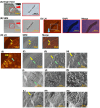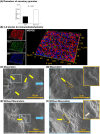A novel method of correlative light and electron microscopy in cryosectioning of bovine anterior pituitary tissue using NanoSuit CLEM
- PMID: 40803882
- PMCID: PMC12511776
- DOI: 10.1262/jrd.2025-025
A novel method of correlative light and electron microscopy in cryosectioning of bovine anterior pituitary tissue using NanoSuit CLEM
Abstract
Correlative light-electron microscopy (CLEM) combines fluorescence microscopy and scanning electron microscopy (SEM) to achieve nanoscale resolution while highlighting regions of interest identified by fluorescence microscopy. CLEM is becoming increasingly important in life sciences but traditionally requires highly dried samples to withstand the high vacuum of SEM. The NanoSuit method, which mimics native extracellular substances, was developed to address this limitation by encasing samples in a thin, vacuum-proof membrane, allowing SEM observation of live or wet multicellular organisms. While previous NanoSuit CLEM studies focused on formalin-fixed paraffin-embedded sections and cultured cells, cryosections had not yet been explored. In this study, NanoSuit CLEM with diluted NanoSuit solution was applied to cryosections of bovine anterior pituitary tissue. Secretory granules in gonadotrophs, which constitute less than 12% of anterior pituitary cells, were successfully visualized. However, other organelles remained unobserved due to fixation conditions. Therefore, NanoSuit CLEM enabled visualization of the ultrastructure of important cells in cryosections, even from large animals.
Keywords: Exocytosis; Gonadotroph; Luteinizing hormone; NanoSuit; Surface shield enhancer effect.
Conflict of interest statement
The authors have nothing to declare.
Figures


References
-
- Timmermans FJ, Otto C. Contributed review: Review of integrated correlative light and electron microscopy. Rev Sci Instrum 2015; 86: 011501. - PubMed
-
- Itoh T, Yamada S, Ohta I, Meguro S, Kosugi I, Iwashita T, Itoh H, Kanayama N, Okudela K, Sugimura H, Misawa K, Hariyama T, Kawasaki H. Identifying active progeny virus particles in formalin-fixed, paraffin-embedded sections using correlative light and scanning electron microscopy. Lab Invest 2023; 103: 100020. - PubMed

